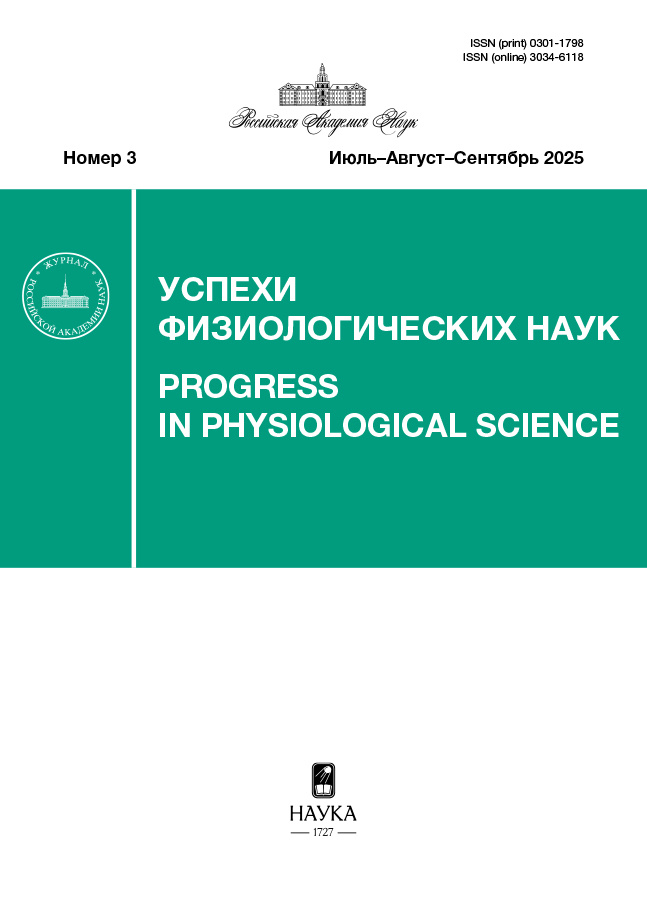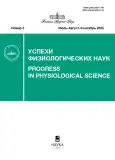Успехи физиологических наук
Свидетельство о регистрации СМИ: ПИ № ФС 77 - 68565 от 31.01.2017
В журнале публикуются материалы обзорно-критического характера по различным разделам физиологии, а также статьи, в которых авторы на основе имеющейся научной литературы излагают оригинальные концепции по принципиальным теоретическим вопросам, аргументированные собственным экспериментальным материалом.
Журнал рассчитан на педагогов и специалистов-физиологов и биофизиков медицинского и общебиологического профиля.
Журнал основан в 1970 году.
Текущий выпуск
Том 56, № 3 (2025)
Статьи
Инсулин в мозге: пути доставки, механизмы действия, применение интраназального инсулина для лечения сахарного диабета и метаболического синдрома
Аннотация
Инсулин традиционно считают гормоном панкреатического происхождения, который регулирует глюкозный гомеостаз и широкий спектр метаболических и гормональных процессов на периферии. Однако в последние десятилетия получены убедительные доказательства того, что инсулин также контролирует множество процессов в мозге, выполняя функции нейротрофического фактора, нейромодулятора и нейропротектора, причем некоторые области мозга способны синтезировать инсулин de novo. Свои эффекты в ЦНС инсулин реализует через инсулиновую сигнальную систему, которая по структурно-функциональной организации и механизмам регуляции имеет значительное сходство с таковой на периферии. Поскольку общий пул инсулина в ЦНС складывается из инсулина, продуцируемого β-клетками и поступающего в мозг через гематоэнцефалический барьер (ГЭБ), и гормона, синтезируемого структурами мозга, то снижение его продукции или ослабление транспорта через ГЭБ приводят к дефициту инсулина в мозге и нарушению его сигнализации. Другими причинами ослабления инсулинового сигналинга в мозге являются центральная инсулиновая резистентность, нейровоспаление, обусловленное повышением активности провоспалительных факторов, развитием реактивного астроглиоза и активацией микроглии, а также повышение активности ферментов, вызывающих деградацию инсулина. Одним из перспективных подходов для эффективного восстановления инсулинового сигналинга в ЦНС является применение интраназально вводимого инсулина (ИВИ), который по аксональным путям попадает непосредственно в мозг. В настоящее время ИВИ применяется в клинике для лечения пациентов с болезнью Альцгеймера и с когнитивным дефицитом, ассоциированным с сахарным диабетом 2 типа (СД2). Однако этим терапевтический потенциал ИВИ не исчерпывается. Нами показано, что ИВИ эффективен при коррекции метаболических и гормональных нарушений, ассоциированных с СД1, СД2, метаболическим синдромом и ожирением, причем ряд его восстанавливающих эффектов усиливается при комбинированном применении ИВИ с метформином, С-пептидом проинсулина, ганглиозидами, вводимыми как системно, так и интраназально. Это указывает на то, что мишенями ИВИ при диабетической патологии и ожирении являются не только структуры мозга, но и периферические органы и ткани, включая компоненты гонадной и тиреоидной систем. Настоящий обзор посвящен проблеме инсулиновой сигнализации в мозге, ее нарушениям при различной патологии, применению ИВИ для восстановления активности инсулиновой системы мозга, в том числе с целью нормализации нейрокогнитивных, метаболических и гормональных показателей при диабетической патологии.
Успехи физиологических наук. 2025;56(3):3-23
 3-23
3-23


Периваскулярная жировая ткань: роль в регуляции сосудистого тонуса в норме и при ожирении
Аннотация
Периваскулярная жировая ткань (ПВЖТ) окружает большинство кровеносных сосудов млекопитающих, тесный контакт с адвентицией которых даёт основание рассматривать ее в качестве 4-го слоя стенки сосуда. Уникальное расположение ПВЖТ делает значимыми паракринные влияния секретируемых ею факторов, многие из которых являются вазоактивными модуляторами (адипокины, ангиотензины, газотрансмиттеры, цитокины). В физиологических условиях секреция этих веществ вызывает выраженное антисократительное действие на гладкие мышцы сосудов, а существование взаимовлияний между ПВЖТ и сосудистой стенкой позволяет обеспечивать тонкую регуляцию сосудистого тонуса, необходимую для адекватного кровоснабжения органов в соответствии с их метаболическими потребностями. Дисфункция ПВЖТ при ожирении приводит к изменениям в экспрессии продуцируемых веществ, что вызывает трансформацию протективного влияния ПВЖТ на тонус сосудов в просократительное, усиливающее реактивность сосудов к действию вазоконстрикторных агентов и приводящее к повышению артериального давления. Цель обзора – представить современное состояние исследований, направленных на выяснение особенностей функционирования ПВЖТ, влияния секретируемых ею веществ на сосудистый тонус в норме и при дисфункции, вызванной ожирением. Основное внимание уделено паракринным влияниям, изучение которых является предпосылкой для разработки в будущем терапии сосудистых нарушений, нацеленной на нормализацию функционирования и секреторной активности ПВЖТ.
Успехи физиологических наук. 2025;56(3):24-42
 24-42
24-42


Зрительные цели и нейронные сети
Аннотация
Цель данного обзора – представить результаты собственных исследований нейронных сетей, обеспечивающих обнаружение и принятие решений при распознавании «повседневных» зрительных целей: лиц, букв, текста, порядка в хаосе. Цифровые методы синтеза и обработки изображений позволили синтезировать калиброванные наборы тестовых изображений, имитирующих зрительные сцены. Данные сцены содержат цели и помехи с заданными статистическими, пространственными и временными характеристиками, избирательно активирующие или тормозящие модули крупномасштабных нейронных сетей головного мозга человека. Показано, как взаимодействуют сети, представляющие фовеолярное и макулярное зрение. В результате работы оппонентных нейронных сетей префронтальной коры происходит принятие решений при распознавании целей. Каждая из крупномасштабных нейронных сетей мозга вовлекается в различные комбинации, обеспечивающие целенаправленную деятельность человека. Рассмотрена работа механизмов локального и глобального анализа сцен при поиске целей: распознавании текста, мимики и поворота лиц, матриц элементов Габора с разной степенью упорядоченности. На основе сверточных, диффузионных и генеративных нейронных сетей построены модели этих механизмов. Показано влияние статистических свойств изображений и их внутреннего контента на принятие решений человеком и машиной. Показаны пути развития психофизиологических исследований организации и деятельности крупномасштабных нейронных сетей «зрительной» системы человека.
Успехи физиологических наук. 2025;56(3):43-59
 43-59
43-59


Формирование слуховых объектов и его отражение в вызванных потенциалах мозга
Аннотация
Избирательное распознавание звука на фоне конкурирующих звуков (разделение слуховой фигуры и фона) является одной из основных проблем, с которыми сталкивается слушатель в повседневных ситуациях. Компоненты сложных акустических сцен часто перекрываются как по времени, так и по частотному составу. Слуховая система человека непрерывно анализирует их с помощью механизмов одновременной и последовательной группировки, либо формируя устойчивые слуховые объекты, либо демонстрируя переключения восприятия между разделенной и интегрированной организацией звукового потока. Цель обзора – описать слуховые вызванные потенциалы (ВП) как средство исследования перцептивного разделения слуховых объектов в разных экспериментальных парадигмах. Особое внимание в обзоре уделено роли пространственных признаков звука. Они могут вносить значительный вклад в выделение слуховых объектов, хотя и меньший по сравнению с частотными или временными характеристиками. Предсознательное разделение объектов при одновременной группировке и при выделении фигуры из фона отражает потенциал ORN (object-related negativity). Следующая за ORN позитивная волна P400 предположительно связана с когнитивными процессами определения количества звучащих объектов. Анализ ВП позволяет исследовать разные этапы разделения звуковых потоков, когда продолжающаяся стимуляция не меняется, а ее восприятие регулярно переключается между двумя перцептами. Индикаторами переключения восприятия в различных экспериментальных условиях могут выступать компоненты ВП: P1, N1, N2, P3a, MMN и длящийся потенциал. Вклад локализационных признаков в показатели ЭЭГ при выделении фигуры из фона остается недостаточно изученным. С точки зрения фундаментального подхода важно, что разделение потоков происходит уже на предсознательном этапе восприятия, но может проявляться также и в поздних компонентах ВП, связанных с переключением внимания. В целом ВП являются потенциальным клиническим инструментом для оценки формирования слуховых объектов в реальных акустических условиях.
Успехи физиологических наук. 2025;56(3):60-79
 60-79
60-79


Механизмы старения мозга и возрастных изменений когнитивных функций
Аннотация
В связи с развитием медицины и повышением уровня жизни в мире возрастает доля пожилого населения, в связи с этим становится актуальным изучение механизмов возрастных изменений когнитивных функций. Цель настоящего обзора – анализ данных литературы о механизмах возрастных изменений когнитивных функций и оценка перспективы развития ключевых направлений исследований в данной области науки. В обзоре приведены современные теории когнитивного старения (теория резерва, компенсаторная теория, теория старения лобных долей, теория дефицита торможений, теория сенсорной депривации). Назрела необходимость объединить данные отдельных разрозненных исследований молекулярных механизмов старения, отражающих роль ряда генов, нейротрофических факторов, тандемных повторов ДНК в обеспечении когнитивных функций в пожилом возрасте. Понимание механизмов когнитивного старения на разных уровнях организма может способствовать разработке эффективных методов профилактики и терапии когнитивных нарушений.
Успехи физиологических наук. 2025;56(3):80-96
 80-96
80-96


Регуляция клетками эндотелия осмотического баланса матрикса роговицы
Аннотация
В обзоре обобщены результаты современных исследований о регуляции молекулярных механизмов клеток эндотелия роговицы, поддерживающих уровень гидратации стромы, необходимый для сохранения ее оптических свойств. Функционирование эндотелия роговицы рассматривается в терминах модели «насос-утечка», в рамках которой приведены данные о роли механизма регуляции собственного водно-электролитного баланса клеток эндотелия, который непосредственно связан с регуляцией клеточного объема. Рассмотрена роль Na/К-АТФазы как электрогенного транспортера и участника системы механорецепторов, включающих белки плотных соединений и комплексов адгезии с внеклеточным матриксом, воспринимающих изменения внутриглазного давления. Приведены данные о молекулярных транспортерах плазматической мембраны клеток эндотелия, участии в их регуляции осмо-чувствительного фактора NFAT5. В разделе, посвященном регуляции процессов регенерации функции эндотелия, рассматриваются современные методы клеточной и тканевой инженерии, разрабатываемые как подходы для лечения отеков роговицы, связанных с дисфункцией эндотелия.
Успехи физиологических наук. 2025;56(3):97-108
 97-108
97-108










